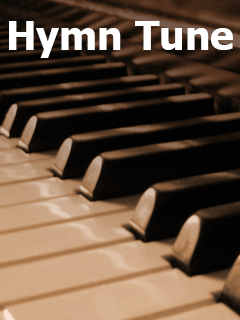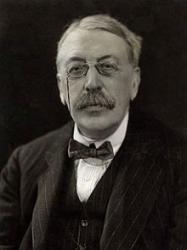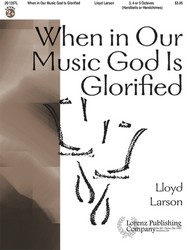- |
User Links
ENGELBERG

ENGELBERG
Composer: Charles V. Stanford (1904)Published in 144 hymnals
Printable scores: PDF, MusicXML
Audio files: MIDI, Recording
Composer: Charles V. Stanford
 Sir Charles Villiers Stanford (30 September 1852 – 29 March 1924) was an Irish composer, teacher and conductor. Born to a well-off and highly musical family in Dublin, Stanford was educated at the University of Cambridge before studying music in Leipzig and Berlin. He was instrumental in raising the status of the Cambridge University Musical Society, attracting international stars to perform with it.
While still an undergraduate, Stanford was appointed organist of Trinity College, Cambridge. In 1882, aged 29, he was one of the founding professors of the Royal College of Music, where he taught composition for the rest of his life. From 1887 he was also the professor of music at Cambridge. As a teacher, Stanford was sceptical about moder… Go to person page >
Sir Charles Villiers Stanford (30 September 1852 – 29 March 1924) was an Irish composer, teacher and conductor. Born to a well-off and highly musical family in Dublin, Stanford was educated at the University of Cambridge before studying music in Leipzig and Berlin. He was instrumental in raising the status of the Cambridge University Musical Society, attracting international stars to perform with it.
While still an undergraduate, Stanford was appointed organist of Trinity College, Cambridge. In 1882, aged 29, he was one of the founding professors of the Royal College of Music, where he taught composition for the rest of his life. From 1887 he was also the professor of music at Cambridge. As a teacher, Stanford was sceptical about moder… Go to person page >Tune Information
| Title: | ENGELBERG |
| Composer: | Charles V. Stanford (1904) |
| Place Of Origin: | Ireland |
| Meter: | 10.10.10 with alleluias |
| Incipit: | 51325 67165 55432 |
| Key: | G Major |
| Copyright: | Public Domain |
Texts
When in Our Music God Is GlorifiedWe Know that Christ Is Raised
All Praise to Thee, for Thou, O King Divine
Alternative Tunes
Charles V. Stanford (b. Dublin, Ireland, 1852; d. Marylebone, London, England, 1924) composed ENGELBERG as a setting for William W. How's "For All the Saints" (505). The tune was published in the 1904 edition of Hymns Ancient and Modern with no less than six different musical settings. It is clearly a fine congregational hymn but also a stunning choral anthem when used with some of the additional settings that Stanford supplied.
ENGELBERG is an attractive, energetic melody with many ascending motives, designed for unison singing with no pauses between stanzas. Try using other instruments in addition to organ (as stanza 5 suggests). Accompanists could play the third and fourth stanzas in a more subdued manner and then play the climactic final stanza with great strength and vigor.
A distinguished composer and teacher of composition, Stanford began his musical career at an early age. Before the age of ten he had composed several pieces and given piano recitals of works by Handel and Bach. He studied at Queen's College, Cambridge, England, as well as in Leipzig and Berlin. At the age of twenty-one he was asked to become organist at the famous Trinity College, Cambridge. At that time he also began a prestigious career in conducting, which included appearances with the London Bach Choir from 1885 to 1902, and he traveled widely in England, Europe, and the United States. His teaching career was equally impressive. Stanford taught composition at both the Royal College of Music and Cambridge University; among his students were Ralph Vaughan Williams (PHH 316) and Gustav Holst. He was knighted in 1902. Stanford wrote over two hundred compositions in nearly all musical genres, including symphonies, operas, chamber music, and songs. Most notable in his church music are several complete services, anthems, and unison hymn tunes.
--Psalter Hymnal Handbook
Notes
Charles V. Stanford (b. Dublin, Ireland, 1852; d. Marylebone, London, England, 1924) composed ENGELBERG as a setting for William W. How's "For All the Saints" (505). The tune was published in the 1904 edition of Hymns Ancient and Modern with no less than six different musical settings. It is clearly a fine congregational hymn but also a stunning choral anthem when used with some of the additional settings that Stanford supplied.
ENGELBERG is an attractive, energetic melody with many ascending motives, designed for unison singing with no pauses between stanzas. Try using other instruments in addition to organ (as stanza 5 suggests). Accompanists could play the third and fourth stanzas in a more subdued manner and then play the climactic final stanza with great strength and vigor.
A distinguished composer and teacher of composition, Stanford began his musical career at an early age. Before the age of ten he had composed several pieces and given piano recitals of works by Handel and Bach. He studied at Queen's College, Cambridge, England, as well as in Leipzig and Berlin. At the age of twenty-one he was asked to become organist at the famous Trinity College, Cambridge. At that time he also began a prestigious career in conducting, which included appearances with the London Bach Choir from 1885 to 1902, and he traveled widely in England, Europe, and the United States. His teaching career was equally impressive. Stanford taught composition at both the Royal College of Music and Cambridge University; among his students were Ralph Vaughan Williams (PHH 316) and Gustav Holst. He was knighted in 1902. Stanford wrote over two hundred compositions in nearly all musical genres, including symphonies, operas, chamber music, and songs. Most notable in his church music are several complete services, anthems, and unison hymn tunes.
--Psalter Hymnal Handbook
Timeline
Arrangements
Harmonizations, Introductions, Descants, Intonations
|
Harmonizations, Introductions, Descants, Intonations: Organ, Brass, and Voices
|
Harmonizations, Introductions, Descants, Intonations: Trombone Counter-melody
|
Harmonizations, Introductions, Descants, Intonations: Trumpet Descant
|
Organ Solo
|
Piano Solo
|
Piano and Organ Duet
|
Instruments: Instrumental Solo with Organ
|
Instruments: Instrumental Solo
|
Instruments: Organ and Trumpet
|
Voices: Organ, Brass, and Voices
|
Media
Psalter Hymnal (Gray) #512
Text: When in Our Music God Is Glorified- Full Score (Made with Sibelius) (XML)
Small Church Music #635
- PDF Score (PDF)
Worship and Rejoice #7
Text: When in Our Music God Is Glorified- Audio recording from Evangelical Lutheran Worship #449
- Audio recording from Evangelical Lutheran Worship #546
- Audio recording from Evangelical Lutheran Worship #851
- Audio recording from Glory to God: the Presbyterian Hymnal #485
- Audio recording from Glory to God: the Presbyterian Hymnal #641
- Audio recording from Lift Up Your Hearts: psalms, hymns, and spiritual songs #795
- Audio recording from Lift Up Your Hearts: psalms, hymns, and spiritual songs #795
- Audio recording from Lift Up Your Hearts: psalms, hymns, and spiritual songs #795
- Audio recording from Lift Up Your Hearts: psalms, hymns, and spiritual songs #795
- Audio recording from Lift Up Your Hearts: psalms, hymns, and spiritual songs #925
- Audio recording from Lift Up Your Hearts: psalms, hymns, and spiritual songs #925
- Audio recording from Lift Up Your Hearts: psalms, hymns, and spiritual songs #925
- Audio recording from Lift Up Your Hearts: psalms, hymns, and spiritual songs #925
- Audio recording from Lift Up Your Hearts: psalms, hymns, and spiritual songs #925
- Audio recording from Lift Up Your Hearts: psalms, hymns, and spiritual songs #925
- MIDI file from Psalter Hymnal (Gray) #512
- MIDI file from Psalter Hymnal (Gray) #512
- Audio recording from Small Church Music #635
- Audio recording from Small Church Music #635
- Audio recording from Small Church Music #635
- Audio recording from Small Church Music #3567
- MIDI file from Sing! A New Creation #294
- Audio recording from The United Methodist Hymnal #68
- MIDI file from The United Methodist Hymnal #68
- Audio recording from The United Methodist Hymnal #610
- MIDI file from Worship and Rejoice #7


 My Starred Hymns
My Starred Hymns






